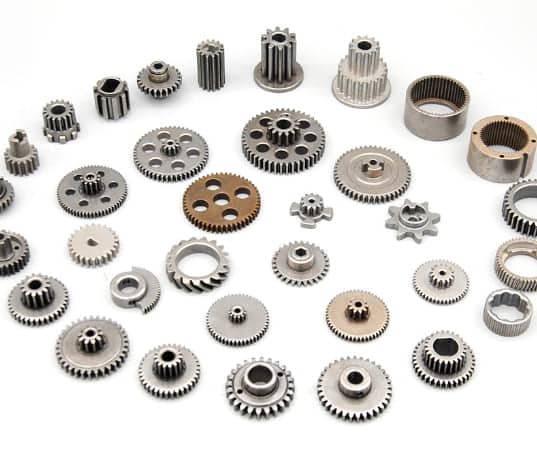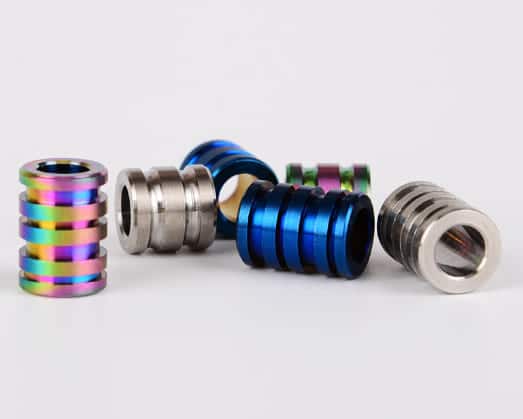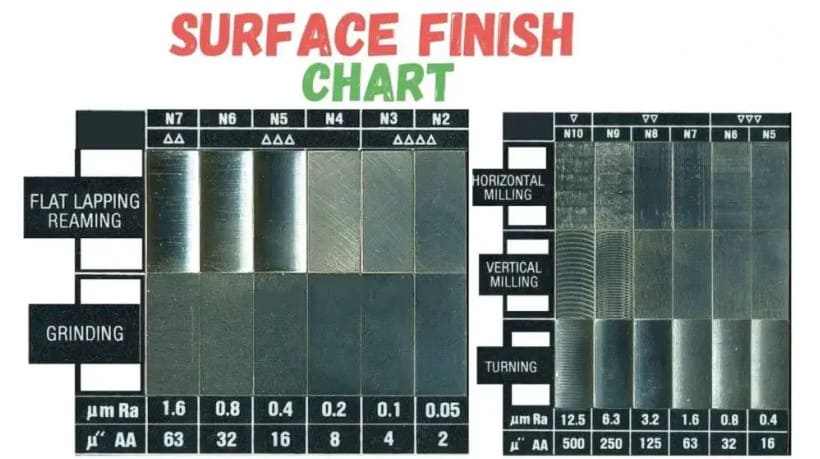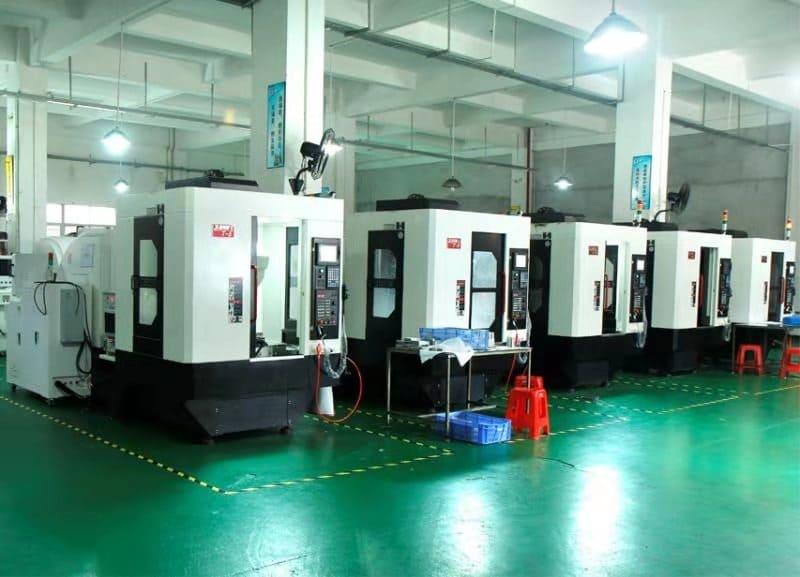Picture an orchestra of interlocking teeth that bring machines to life. Behind the scenes, gears propel our world with mechanical marvels.
Everyday objects like bicycles, cars, clocks, and industrial machinery function due to cogs.
Thus, in today’s post, we will shed some light on the different types of gear. Explore the different types of gear and uncover the secrets of their functionality.
Whatever your interest, this article will take you on a journey if you’re eager to learn.
We’ll explore spur gears’, bevel gears’ complexity, and worm gears’ ingenious mechanics together. You’ll see how gears work together and transform rotational energy into motion.
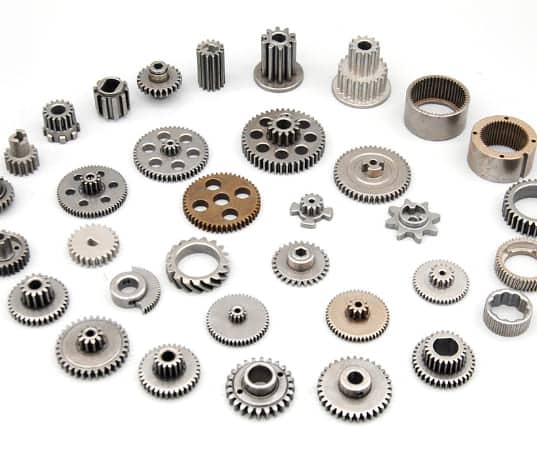
Gear Essentials: Understanding Importance and Classification of Gears
With utmost precision, gears convert and transmit power in mechanical systems. They are used in many applications, from everyday devices to large industrial machinery.
Importance of Gears in Mechanical Systems
Gears play a vital role in mechanical systems, transmitting power and motion with remarkable precision. Let’s explore why gears make machines and devices work smoothly.
1. Power Transmission
Power transmission relies on gears. In mechanical systems, they allow rotational force to be transferred between parts.
The meshing of gears ensures the efficient transmission of torque, ensuring the desired output.
2. Speed Reduction and Amplification
Gears provide the ability to modify the rotational speed. You must reduce or increase the input source’s speed for many applications to match the output speed.
By using different numbers of teeth, gears can reduce or amplify speed, allowing systems to operate as fast as they want.
3. Torque Multiplication
One of the gears’ most significant advantages is that they multiply torque. You can increase or decrease the input torque using gears of different sizes.
It’s great for applications like heavy machinery or vehicles that require much torque.
4. Directional Changes
In mechanical systems, gears are often used to change the direction of motion. Specific gear arrangements can redirect rotational motion at different angles, such as bevel or worm gears.
Doing this allows you to create complex systems that transmit motion in multiple directions.
5. Synchronization of Components
Many machines and devices use gears to synchronize the movement of different components. The multiple gears in a system work together to make sure different parts move at the same time.
The synchronization of these processes is crucial to achieving smooth and coordinated operations.
Overview of Gear Classification and Design
Depending on the system’s requirements, gears come in different shapes, sizes, and configurations.
They can be classified based on tooth profiles, arrangements, and relative positions. Understanding the different gear classifications is essential to understanding their functionalities and applications.
The design of gears considers factors such as load capacity, speed, noise, efficiency, and backlash. The engineers carefully consider these aspects to optimize gear performance and ensure longevity.
Recommended: Custom Machined Gears for Kinds of Industries, Offer Free Drawing Design
Understanding gear classifications and design principles will allow us to understand how they work and choose better gears.
Next, we will explore the world of gear classification, uncovering their unique characteristics and uses in detail.
The 4 Main Types of Gears
There are various types of gears, each with its characteristics and applications. These are the four main types of gear you need to know.
1. Spur Gears
A spur gear is the most common and straightforward type of gear. These gears have cylindrical teeth aligned parallel to the gear’s axis.
Spur gears provide efficient power transmission and are cost-effective to manufacture due to their simplicity.
They are generally used in applications where noise isn’t a concern, such as electric drills, conveyor systems, and washing machines.
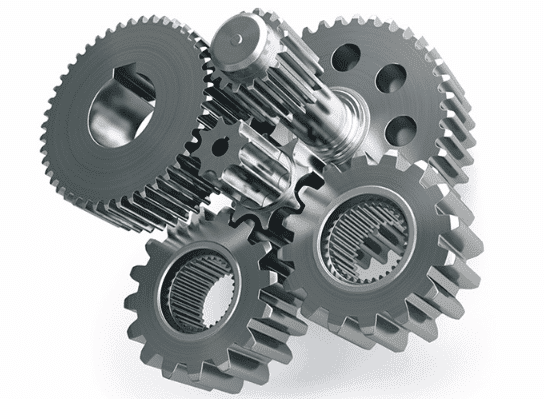
2. Helical Gears
A helical gear has angled teeth arranged in a helix pattern around its circumference. Due to this helical design, these gears operate more smoothly and quietly than spur gears.
The angled teeth enable gradual tooth engagement, reducing impact forces and enhancing load-bearing capacity.
Many industries use helical gears, including automotive transmissions, industrial machinery, and power generation.
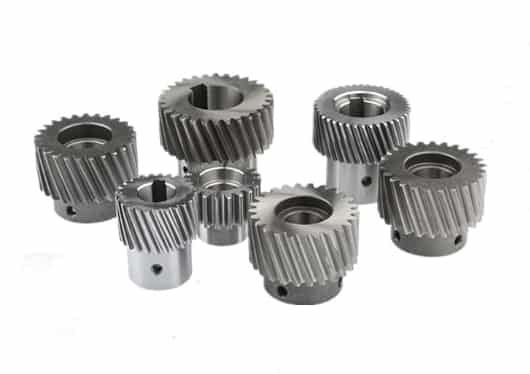
3. Bevel Gears
Bevel gears are specially designed to transmit power and motion between intersecting shafts.
They have conical-shaped teeth and come in two main types: straight bevel gears and spiral bevel gears.
A straight bevel gear has straight teeth and is primarily used in low-speed applications.
Conversely, spiral bevel gears have curved teeth and are more suitable for high-speed and heavy-duty applications, like automotive differentials, marine propeller drives, and locomotives.
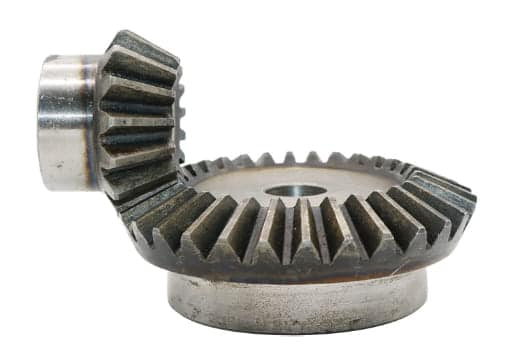
4. Worm Gears
A worm gear consists of a worm (a threaded shaft) and a gear (usually called a worm wheel).
Worm teeth mesh with gear teeth, allowing large gear reductions and high torque transmission.
Worm gears are known for their self-locking properties, which prevent them from being back-driven by the worm.
The worm gear is ideal for applications requiring holding power or preventing reverse motion, such as lift mechanisms, conveyor systems, and steering wheels.
The four main types of gears all have different properties. It is essential to understand their distinct features and capabilities to select the right gear type.
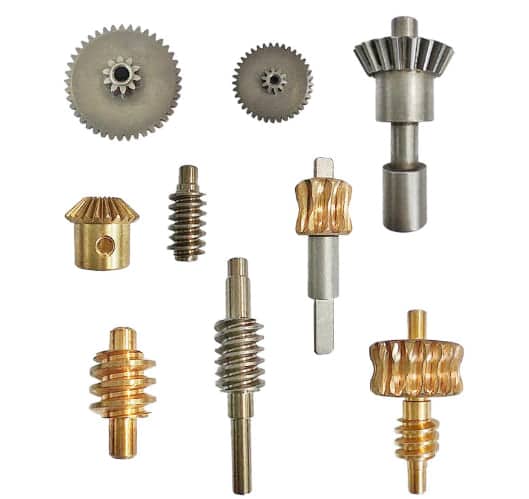
Five Design Categories of Gears
Gears are available in various styles and designs, each tailored to a specific application. This section will explore five key gear categories
1. External Gears
The most common and widely used type of gear is the external gear, also known as spur gear.
They consist of cylindrical gears with teeth located on the outer circumference. External gears have teeth parallel to the gear axis and engage with the teeth of other external gears to transmit power.
The simplicity, cost-effectiveness, and efficiency of external gears make them perfect for power transmission.
Their applications include automotive transmissions, industrial machinery, consumer appliances, and power tools.
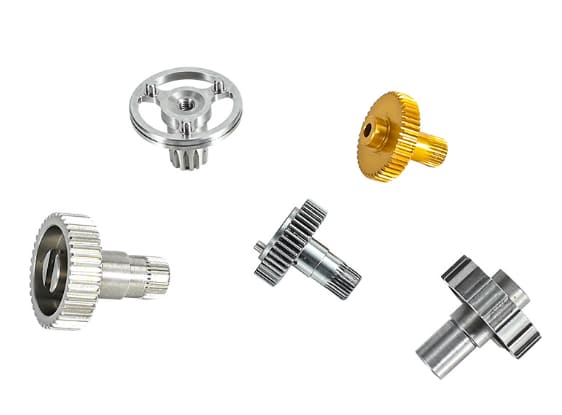
2. Internal Gears
An internal gear has teeth around its inner circumference and meshes with an external gear of a larger diameter.
The advantages of internal gears include compactness, torque transmission, and load distribution.
Compared to external gears, internal gears can handle higher loads and provide smoother operation due to their larger number of teeth engaged at any given time.
They’re commonly used in applications with limited space, like planetary gear systems, gear pumps, certain gear reducers, and automotive parts.
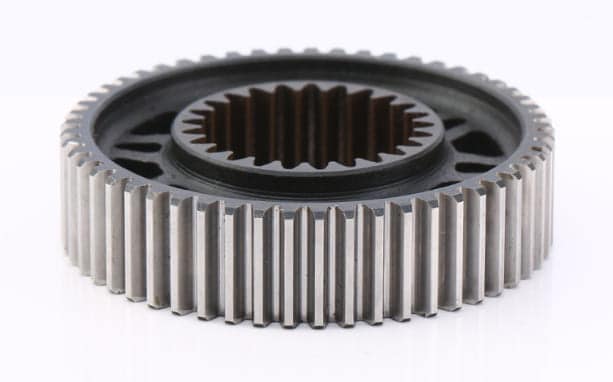
3. Rack and Pinion Gears
Rack and pinion gears combine a linear gear (rack) and a cylindrical gear (pinion). The rack has straight teeth, and the pinion meshes with the rack to convert rotational motion into linear motion.
Rack and pinion gears are widely used in applications requiring precise linear movement. Steering systems, machine tools, linear actuators, and various industrial machinery convert rotational motion into linear motion.
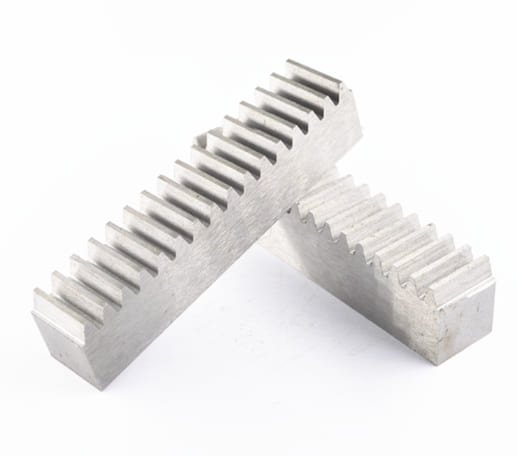
4. Planetary Gears
Planetary gears, also called epicyclic gears, are highly flexible and efficient gear systems.
They consist of a central gear called the sun gear, multiple planet gears that mesh with the sun gear, an outer ring gear, or annulus.
The advantages of planetary gears include high power density, compactness, and achieving multiple gear ratios.
Their wide application ranges from automotive transmissions, robotics, and aerospace to industrial machinery.
5. Non-circular Gears
Gears with non-circular tooth profiles differ from traditional circular gears in their tooth profiles. They are designed to accomplish specific motion patterns or control mechanisms.
These gears are used in applications that require precision motion control, speed variations, or intermittent motion.
They’re used in cam mechanisms, printing presses, rotary engines, and other mechanical systems that need custom motion profiles.
Three Categories of Gears and Their Efficiencies
There are three kinds of gears based on their axis orientation: parallel-axis gears, intersecting-axis gears, and non-parallel, non-intersecting-axis gears.
Each category offers unique advantages and considerations regarding efficiency.
1. Parallel-axis Gears and Their Efficiencies
Parallel-axis gears refer to gears whose axes of rotation are parallel to each other. This configuration involves the transmission of power between two parallel shafts.
The efficiency of parallel-axis gears is generally high, often exceeding 95%.
The direct contact between gear teeth minimizes frictional losses and therefore increases efficiency.
Typical applications for parallel-axis gears include automotive transmissions, industrial machinery, and power generation systems.
2. Intersecting-axis Gears and Their Efficiencies
Intersecting-axis gears are gears that have axes of rotation that intersect each other.
These gears transmit power and motion between two shafts positioned at an angle concerning each other.
The efficiency of intersecting-axis gears varies depending on gear type, tooth profile, and lubrication factors.
In general, intersecting-axis gears are less efficient than parallel-axis gears. Even so, proper design, manufacturing, and lubrication can still improve their efficiency.
There are a variety of applications for intersecting-axis gears, including bevel gear drives, worm gear drives, and some types of gearboxes.
3. Non-parallel, Non-intersecting-axis Gears and Their Efficiencies
The term non-parallel, non-intersecting-axis gear refers to gears with axes of rotation that are not parallel or intersecting.
Non-parallel, non-intersecting-axis gears have axes of rotation that are not parallel or intersecting.
The efficiency of these gears varies widely depending on their specific design and operating conditions.
The complexity and potential misalignments in such gear systems can make achieving high efficiency challenging.
Planetary gear systems, differential gear systems, and special-purpose machinery commonly use non-parallel, non-intersecting-axis gears.
The efficiency of gears is an essential factor to consider when selecting them.
The 7 Types of Gears
The knowledge of different types of gear is essential for engineers and enthusiasts alike. Throughout this section, we will explore the seven main types of gear.
1. Spur Gears
Spur gears are the most common and have straight teeth parallel to the gear axis. They offer several advantages, including high efficiency, design simplicity, and manufacturing ease.
Spur gears transmit power smoothly and reliably because their teeth engage directly. These motors are widely used in clocks, gear pumps, conveyor systems, and power tools because they rotate easily and efficiently.
2. Helical Gears
Helical gears are designed with teeth angled relative to the gear axis, forming a helix shape. This design allows for gradual tooth engagement, resulting in smoother and quieter operation than spur gears.
The advantages of helical gears include higher load-carrying capacities, increased surface contact areas, and improved tooth strength.
Automotive transmissions, industrial machinery, and power tools use them for high-speed, high-load transmissions.
3. Bevel Gears
The teeth on bevel gears are cut on conical surfaces, transmitting the motion between intersecting shafts. It’s designed to transmit power and motion at various angles, usually 90°.
The high efficiency, compact design, and versatility of bevel gears make them ideal for transmitting torque between shafts that are not parallel.
Differential drives, automotive drivetrains, machine tools, and marine propulsion systems commonly use them.
4. Worm Gears
A worm gear consists of a cylindrical worm (a screw-like gear) and its mating gear, called a worm wheel.
High gear reduction ratios, compact design, and self-locking capabilities are some of the advantages of worm gears.
The sliding contact between the worm and worm wheel transfers torque and controls motion effectively.
Elevators, conveyors, heavy machinery, and automotive steering systems use worm gears for high-torque transmission and braking.
5. Rack and Pinion Gears
Rack and pinion gears consist of a linear gear, known as the rack, and a cylindrical gear, known as the pinion.
This gear combination converts rotational motion into linear motion or vice versa.
Simple, high-efficiency, and precise linear movement are some benefits of rack and pinion gears.
These are commonly used in steering systems (cars and industrial machinery), CNC machines, robotics, and linear actuators.
6. Planetary Gears
Planetary gears, also called epicyclic gears, consist of the sun gear and multiple planet gears that mesh with the sun gear and outer ring gear.
Planetary gears offer several advantages, including high torque density, compact size, and achieving multiple gear ratios within one system.
These are widely used in automotive transmissions, robotics, aerospace, and various industrial machinery where compactness and efficiency are essential.
7. Hypoid Gears
Hypoid gears are similar to bevel gears but have offset and non-intersecting axes. This design allows for efficient power transmission and torque transfer at right angles.
Hypoid gears have advantages such as high torque capacity, compactness, and reduced noise.
They’re commonly used in automotive differentials, power tools, heavy-duty machinery, and industrial gearboxes.
Each of these seven types of gear has its characteristics and advantages. Depending on their strengths and capabilities, you can make informed gear selections for mechanical systems.
Factors to Consider when Selecting a Gear
There are several key factors to consider when selecting the right gear for a specific application.
These factors help ensure the chosen gear meets the application’s requirements and performs optimally. Here are some essential factors to consider:
Load Capacity
The load capacity of a gear refers to its ability to transmit and withstand a given amount of force.
You must evaluate the anticipated load and choose the right gear to prevent premature wear, excessive deformation, or gear failure.
Speed Requirements
Speed is one of the most important factors to consider when choosing gears. There are different types of gear with varying speed capabilities, so selecting the right gear for the desired speed range is crucial.
The effects of exceeding the recommended speed limits include increased wear, noise, and inefficiency.
Space Constraints
It is essential to consider the space available within the machinery or system. Gears come in various sizes and configurations, so they must fit into the designated space without compromising functionality.
Operating Conditions
Consider the operating conditions under which the gear will be used. Temperature, lubrication, harsh environments, and anticipated duty cycles can affect the gear’s performance and longevity.
Select the right gear for your operating conditions to ensure reliable performance.
Application Requirements
Every application requires precision, accuracy, gear ratios, backlash tolerance, and environmental compatibility.
These application-specific requirements help you choose a gear that meets the desired performance criteria and ensures optimal functionality.
Noise Requirements
Selecting gears with features that minimize noise generation is crucial in applications that require noise reduction.
Helical gears, for example, offer smoother tooth engagement and are quieter than spur gears. Choosing a gear type that meets the desired noise levels requires evaluating noise requirements.
Cost Considerations
Cost is another factor that influences gear selection. Manufacturing complexity, materials, and associated costs vary between gear types and designs.
Considering both cost and function when selecting a gear can help to meet both requirements.
In selecting gears for their specific applications, you can evaluate these factors, ensuring optimal performance, reliability, and efficiency.
Gears in CNC Machining
Gears perform several crucial functions in CNC (Computer Numerical Control) machining. Such as:
Application of Gears in CNC Machinery
There are several key applications for gears in CNC machinery.
Power Transmission
Gears transmit power from the motor to moving components within CNC machines, such as the spindle, tool changer, and axis drives.
As a result, the machine can perform accurate and controlled movements due to efficient power transfer.
CNC machines usually have a motor, drive system, and gear mechanisms for power transmission.
Motors generate rotational power, which is transmitted to driven components through gears.
Different machine components commonly use spur gears, helical gears, or gearboxes to achieve the desired speed and torque.
With their precise design and tooth engagement, these gears ensure minimal power loss during transmission.
Speed Reduction
Different machining operations require different rotational speeds on CNC machines. Changing the gear ratio between the motor and the driven components reduces the speed with gears, especially gearboxes.
The machine can achieve the correct cutting speeds and feeds for optimal machining.
However, higher rotational speeds with lower torque are preferred for fine finishing or high-speed machining to maintain smooth surfaces and minimize machining time.
Gears with different tooth profiles, such as spur or helical gears, create gear ratios and reduce speed.
Motion Control
Machines move precisely because of gears and precision mechanisms like lead screws and linear guides.
They can do accurate positioning, rapid tool changes, and complex machining by converting rotational motion into linear motion.
As the motor rotates, gears and lead screws or ball screws convert it into linear motion, driving the machine’s axes.
By doing this, the machine can position the cutting tool accurately relative to the workpiece, ensuring precise machining.
Importance of Precise Gear Mechanisms for CNC Accuracy
CNC machining requires accuracy to ensure consistent and high-quality manufacturing. The precision of gear mechanisms plays an important role in the overall accuracy of CNC machines.
The reasons are as follows:
Positioning Accuracy
CNC machining is all about positioning accuracy because it directly affects the final dimensions and quality of the parts.
Inaccuracies or deviations in the axes of the machine can cause dimensional errors and compromise the overall quality.
Precision gear engagement, gear ratios, and backlash control accurately position the machine’s moving parts.
It directly impacts the repeatability and precision of the machining process, resulting in tighter tolerances.
Motion Synchronization
Multiple axes of CNC machines are commonly used to perform intricate machining operations seamlessly.
In complex CNC machining operations, multiple axes (X, Y, and Z) must perfectly synchronize with rotational axes (A, B, and C) to achieve tool paths.
Gear mechanisms ensure proper motion synchronization between these axes, minimizing deviations or errors that could cause inaccurate results.
This synchronization ensures that intricate features, contours, and complex geometries are machined accurately and precisely.
Rigidity and Stability
High-precision gears contribute to a machine’s overall rigidity and stability when designed and manufactured correctly.
It minimizes vibration, flexing, and deflection during machining, maintaining the parts’ accuracy and surface finish.
In CNC machining, rigidity, and stability are crucial since they help the machine maintain precise cutting forces and avoid unwanted vibrations.
Gears have excellent meshing characteristics and load-carrying ability, especially in drive systems and transmissions.
It prevents components such as the spindle and cutting tool from vibrating during machining, improving precision and surface finish.
Tool Life and Efficiency
CNC machines can move tools smoothly and consistently due to the accurate control of gear mechanisms.
And tool life and efficiency are critical factors in CNC machining since they directly impact production costs and overall productivity.
The machine’s axes and tools move smoothly and consistently with precise gear mechanisms.
It minimizes the chances of tool chatter, excessive tool wear, and premature tool failure.
The precision gears extend tool life, reduce tooling costs, and improve machine efficiency by providing stable and controlled tool movements.
Conclusion
Ultimately, gears play an important role in mechanical systems, transferring power, controlling motion, and increasing efficiency.
Whether in aerospace, automotive, or manufacturing industries, gears ensure smooth and accurate operations, increasing productivity.
Knowing the types of gear available and their applications will help you select the best gear for your specific needs.
When choosing gears, you must consider load capacity, speed requirements, and gear mechanisms.
 Call Us Today! (+86) 188-2253-7569
Call Us Today! (+86) 188-2253-7569